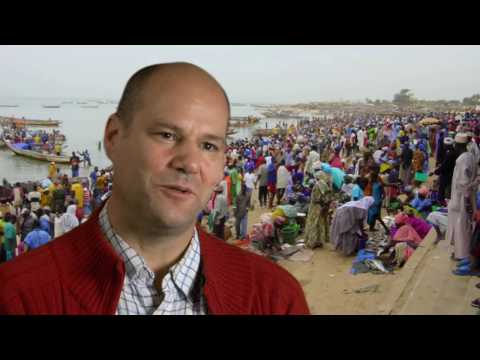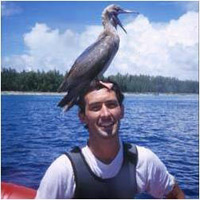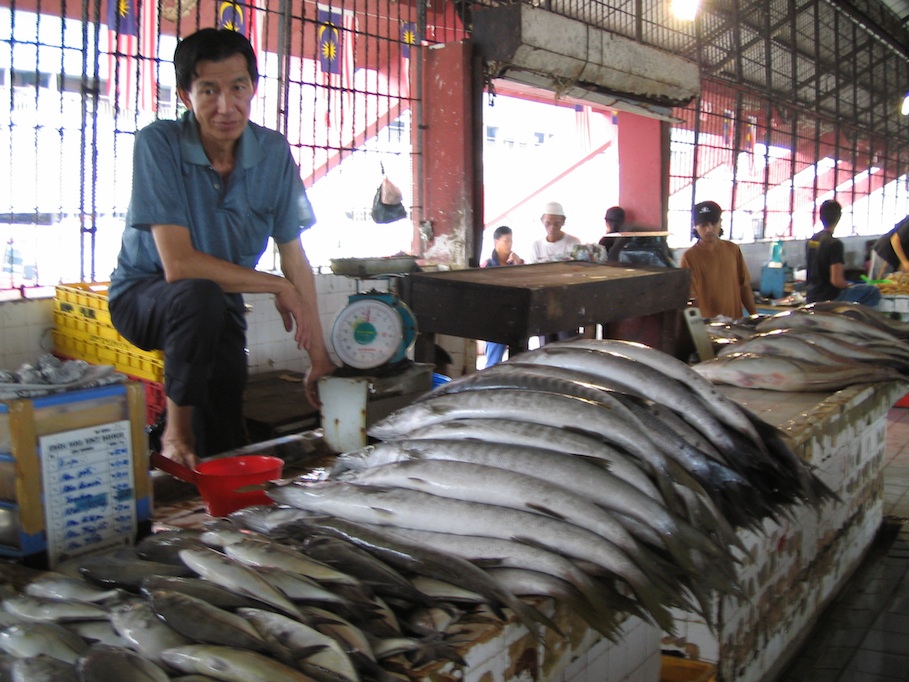 Editor’s note: The following discussion, which more than one participant called “extraordinary”, began after Ray Hilborn of the University of Washington published an op-ed “Let us eat fish” in the New York Times on 14 April 2011, and John Bruno of the University of North Carolina (and my Co-Editor at SeaMonster) replied here at SeaMonster. John’s post was emailed to a list of experts in fisheries and marine ecology, and quickly sparked a wide-ranging online conversation remarkable for its combination of careful argument, thoughtfulness, diversity of perspectives, breadth of expertise, and—perhaps most noteworthy—collegiality. The conversation grew to include many leading scientists and the email exchanges allowed a give-and-take among participants in near real time that would be impossible in the print journals where such discussion traditionally occurs. For all of these reasons, there was broad agreement that the discussion should be made publicly available. And so, here it is.
Editor’s note: The following discussion, which more than one participant called “extraordinary”, began after Ray Hilborn of the University of Washington published an op-ed “Let us eat fish” in the New York Times on 14 April 2011, and John Bruno of the University of North Carolina (and my Co-Editor at SeaMonster) replied here at SeaMonster. John’s post was emailed to a list of experts in fisheries and marine ecology, and quickly sparked a wide-ranging online conversation remarkable for its combination of careful argument, thoughtfulness, diversity of perspectives, breadth of expertise, and—perhaps most noteworthy—collegiality. The conversation grew to include many leading scientists and the email exchanges allowed a give-and-take among participants in near real time that would be impossible in the print journals where such discussion traditionally occurs. For all of these reasons, there was broad agreement that the discussion should be made publicly available. And so, here it is.
Emmett Duffy
Forum Editor, www.theseamonster.net
The following contributions are listed in approximately the chronological order in which they were written.
 Ray Hilborn
Ray Hilborn
“Let us eat fish” (Op-ed piece in the New York Times)
 John Bruno
John Bruno
“Let us eat (other people’s) fish” (Reply at SeaMonster)
Discussion participants (in alphabetical order)
Edward H. Allison
Trevor Branch
John Bruno
Villy Christensen
Emmett Duffy
Didier Gascuel
Ray Hilborn
Les Kaufman
Phil Levin
Camilo Mora
Callum Roberts
Peter Sale
Rashid Sumaila
Boris Worm
 Ray Hilborn
Ray Hilborn
Professor, School of Aquatic & Fishery Sciences
University of Washington
USA
Dear Dr. Bruno:
I thought a few comments on your comments might prove an interesting starting point for further discussion.
When Boris Worm and I started working together we looked for reasons we had such different perspectives. My preferred hypothesis was that it depended on where you worked, Boris worked in the N Atlantic, a region that had been subject to overfishing for many years, whereas I worked largely in the Pacific, where fisheries management had a much better track record. Clearly where you work does not have a good track record at all.
But to some of the key issues.
Overfishing has stopped in U.S. federally managed fisheries. Steve Murawski, former chief scientist for NOAA stated this in January, and current NOAA staff have agreed with one or two exceptions. The stocks subject to overfishing in the NOAA reports are almost exclusively not US but migratory stocks.
You need to distinguish between overfished, that is abundance, and overfishing, the exploitation rate. Mangers can only control fishing pressure, and the U.S. has an excellent record over the last 15 years of reducing fishing pressure.
In the data base in Worm et al 2009 only about 1/3 of stocks have F>FMSY and of these only about 15% of all stocks have F high enough that sustainable yield is significantly reduced. If we are concerned about sustainability, those, and only those, are of serious concern.
Certainly there is a lot of unsustainable fishing practice elsewhere in the world, but the major intent of my op-ed was to point out that US fisheries management is not failing, but remarkably succeeding. Even the Sea Around Us project at UBC has estimated that world fish catch would only increase 10% if all over-fished stocks were rebuilt. The stated objective of most national and international legislation is maximum sustainable yield, and fisheries agencies are doing a pretty good job of achieving that.
What is the status of the rest of the world where we don’t have abundance data. The last time FAO estimated status by region, the places we have data on abundance were more depleted than the places we do not have data. I do suspect that the places we do not have data have not reduced fishing pressure as much as the places we do have data, but because those fisheries are typically newer they just haven’t depleted their stocks as much as was done in the North Atlantic, which is heavily represented in the abundance data set.
Should you eat fish.
If you are concerned about the environmental impacts of your diet, and you are not a vegetarian, then I believe the evidence is overwhelming that eating fish is better for the environment. Livestock production has a much higher carbon footprint than fisheries, requires more freshwater, use more pesticides and herbicides, and causes soil erosion. You avoid all those other forms of environmental damage by eating fish. Even if you are a vegetarian the biodiversity loss of putting land to the plow is much much higher than the biodiversity loss from fishing.
Ray Hilborn
 Rashid Sumaila
Rashid Sumaila
Director, Fisheries Economics Research Unit
University of British Columbia Fisheries Centre
Canada
Dear John,
Thanks for the piece.
I’ve been expecting more fisheries biologists to counter the “Let’s eat more fish” article of Ray Hilborn because (i) based on the economics of world fisheries (including the US) it is not possible for fisheries to be doing as well as Hilborn et al. say they are doing (see comment #11 here); and (ii) anywhere I go (and I’ve been to many fishy places in the world) local scientists, managers and fishers are very worried about their declining fisheries. I just returned from Dubai, and local scientists there believe that the top 8 local fish species in the UAE have decline by up to 87% compared to what they were in the past 2-3 decades.
As for the recent Sea Around Us estimate that world fish catch would only increase 10% if over-fished stocks were rebuilt, this is because if you want sustainable fisheries, you cannot take much more fish even after rebuilding.
Cheers,
Rashid
 Trevor Branch
Trevor Branch
Assistant Professor
School of Aquatic & Fishery Sciences
University of Washington
USA
Hi All,
Obviously it would be difficult to respond in full to a very lengthy blog post choosing facts from different places to illustrate different points.
I am surprised that anyone can compare the complete biodiversity loss from clearcutting rainforests and replacing them with soy beans, with the biodiversity loss from fishing, and conclude that fishing is a worse source of protein. Yes, it is true that many places are overfished (low biomass), including nearshore fisheries, estuaries, and coral reefs. We all are striving for zero overfished stocks and we are far from that. Also, most of us would agree that biomass well above Bmsy is better than biomass below Bmsy because of all the ecosystem benefits.
Two points to consider from Branch et al. (2011), attached: (1) our stock assessments do show approximate stability in stock status in recent years, (2) using time trends in catch alone to assess status results in bias both in estimated status and also in trends over time (bias towards worsening trends).
Finally, everyone assumes that fisheries in Africa, Asia and South America (with poorer data) must be worse off than in Europe and North America (where we do have good data). Actually a variety of information suggests that developed country fisheries could be more depleted, with more lost yield due to overfishing, higher fishing effort, and of course fished with industrial fishing power for much longer. For example, with the caveat that their method is catch-based which may introduce some bias, Srinivasan et al. (2010) show that global lost yield from overfishing is as follows (from worst to best): North America (23%), Europe (19%), Africa (19%), Asia (14%), Oceania (13%), High Seas (11%), South America (7%). What is likely true is that developed countries are now controlling effort better whereas developing countries are continuing to increase effort and deplete stocks.
Trevor
Refs:
Branch, T. A., O. P. Jensen, D. Ricard, Y. Ye, and R. Hilborn. 2011. Contrasting global trends in marine fishery status obtained from catches and from stock assessments. Conservation Biology doi: 10.1111/j.1523-1739.2011.01687.x.
Srinivasan, U. T., W. W. L. Cheung, R. Watson, and U. R. Sumaila. 2010. Food security implications of global marine catch losses due to overfishing. Journal of Bioeconomics 12:183-200.
 Callum M. Roberts
Callum M. Roberts
Professor, Environment Department
University of York
United Kingdom
Dear All,
I can’t resist contributing here. It seems that Ray Hilborn has based his op-ed principally on the state of US fisheries management, and argues that people should eat more fish because US fisheries have begun to dig themselves out of overfishing. But if consumers in the US follow that advice, in reality they will be eating mainly foreign fish, most of it from developing countries where management is patchy, often poor and sometimes nearly non-existant. So it is irresponsible not to include that important caveat in what we write about the state of fisheries. Here is a short extract from NOAA:
“In 2009, imports made up 84% of the seafood eaten in the United States. The United States imported about 5.2 billion pounds of seafood in 2009, 64.4 million pounds less than the quantity imported in 2008. 2009 imports were valued at $13.1 billion, $1.0 billion less than 2008. We mainly import from China, Thailand, Canada, Indonesia, Vietnam, Ecuador, and Chile.”
The rest can be read at: http://www.nmfs.noaa.gov/fishwatch/trade_and_aquaculture.htm
Not all of these imports are from wild catches, but a good chunk of it is. What people in developed countries eat matters a great deal to the state of world fisheries and to food security in developing nations.
Best wishes,
Callum
 Les Kaufman
Les Kaufman
Professor of Biology
Marine Program
Boston University
USA
HI everybody.
This is interesting.
I share Ray’s optimism more than some. Admittedly this may have something to do with my baseline, the New England Fisheries Management Council. In New England we have progressed during my half a lifetime in Boston from somewhere in the early Neolithic to maybe the late Dark Ages/early Renaissance, which thus appears blindingly bright and hopeful by comparison.
But Ray, here’s what I do not understand. The trumpeted success in fisheries is still based on single species equilibrium models and demographic reference points. Basically, we have followed the advice of killing fishes no more quickly than they show up. Even if you buy the equilibrium approximation, which I do only with considerable caveat (i.e. looking at short time spans, system possibly chaotic and there may be more than one attractor, ignore climate change for the moment) I’m just not convinced that every species of interest can be brought down to Bmsy by fishing pressure without loss of valued functions that serve goals other than biomass extraction…including the system resilience necessary to continue to pretend that things are at equilibrium. Maybe what I’m missing is that F is very well managed, tracks temporal flux (e.g. due to climate and/or stochastic year class strength variation) perfectly, and we know enough about M that this takes into account all species interactions…but I don’t feel good about this.
Obviously we are doing much, much better in the developed world than we used to, with a lot of improvement quite recently…but at an impressive cost-of-management that is actually a cryptic subsidy to the fishing industry. What will be the effect of instabilities in both global and national economies and consequent hiatuses in management effectiveness? What are the minimum costs of fisheries science and enforcement for the system to work? What is the cost-benefit of a data gap when we hold exploitation levels so close to the wire? My concern here is more for the people than the fishes. The fishes will recover someday (or not, and something else evolves) and meanwhile suffer no more than usual. But the people may be expecting things of scientists and managers that they/we can not really deliver.
Les
Les:
I think my perspective is simpler — are we restricting fishing effort enough to let the ecosystems continue to function more or less normally, and still produce something near their potential harvest. We use the models etc to benchmark where we are but we really measure our successes either by the New England benchmarks of things improving in abundance, or in the Pacific where we have many kinds of data often from pre-harvest periods, where we are relative to what things were like 50 years ago. So I don’t see the models as that important, and indeed would like to see management systems move away from model based estimates of biomass to harvest regulation based on empirical data like surveys.
I am of course heavily influenced by my work on Alaska salmon, where we have higher abundances than any time in recorded history.
Clearly we cannot have every species at MSY, and as I said in the NYT editorial and we highlighted in Worm et al. 2009, choices must be made as to how much yield we will forgo in order to keep the weaker stocks as high as possible. I didn’t want to give a personal opinion on this, but the NYT editors insisted I say what I thought we should do. From a whole range of reasons I agree that our target exploitation rates should be less than would produce MSY, and I think that choosing your targets to be roughly the economic optimum is a good compromise. I have a paper in review at Conservation Biology showing for the west coast demersal fishery that biomass yield (across 35 stocks) would be maximized at a 6% harvest rate, revenue at about 4% and profit at 2.5%. It would seem reasonable to target to 2.5% (but right now the actual harvest rate is less than half of that).
I don’t see real big concerns about structure and function of marine ecosystems at the kinds of harvest rates that would be economically reasonable, almost all of the major ecosystems shifts that have been fishing induced have occurred at very high harvest rates — much greater than would produce MSY. So if we were to apply the light harvest rates appropriate for profit maximization, I think marine ecosystems would be in very good shape.
There certainly are challenges in understanding how the appropriate exploitation rate should change with environmental changes — we have students working on that right now, but essentially you probably get good results just by lowering your target F in periods of bad conditions, and having a floor abundance when you stop directed fishing. Having said that, you are always going to have stocks at low abundance because they are in a period of poor environmental conditions — using US I am confident we would always have some fraction of stocks “overfished” even in the absence of fishing.
The world outside of Europe, North America, Australia and New Zealand does pose a lot of challenges, and for most of it I don’t think the U.S. model of laws and government funding is likely to work. In those places community based co management is much more likely to be successful, but lots of things need to be tried and we need to find what works.
There certainly are lots of examples of success in the developing world — but also many failures.
Re the costs of management, New Zealand and some other countries recover almost all the costs of fisheries management from commercial fishermen. They seem to be able to manage their fisheries pretty well with that model. The problem is that US fishermen expect the government to pay for all these costs.
Ray
 Camilo Mora
Camilo Mora
Assistant Profess of Biology
Department of Biological Sciences
Dalhousie University
Canada
This is indeed a very interesting discussion but one that resembles other discussions in ecology and evolution, in which we look for black or white answers in a spectrum with many grey options.
I, however, would like to caution on the handling of available evidence and on the implications of our recommendations as scientists. Clearly, there is evidence to support any statement otherwise there will not be a debate in the first place. There is, however, a great danger about cherry picking evidence or making suggestions based on partial evidence. I cannot imagine, for instance, the consequences of suggesting eating more fish to emerging economies like India and China not only for their local fisheries but for fisheries worldwide due to increasing trade and globalization. There seems to be an agreement now that the suggestion to eat more fish is based on evidence from a small geographical area and thus such recommendation needs to be considered with caution for other regions even within the USA.
Similarly, there are other statements put forward in this debate that appear to be one sided or consider only partially the available evidence.
For instance, one person says “I don’t see real big concerns about structure and function of marine ecosystems at the kinds of harvest rates that would be economically reasonable.” This statement underestimates, for instance, the existing evidence on the role of economic subsidies estimated at over nearly 1 trillion dollars per year (Ed: see Branch’s comment in next panel). If it was not for those subsidies many fisheries should be bankrupt by now. One also has to worry about leaving any decision up to the discretion of economists or just see what happened to the USA economy under the Bush administration when economists were left alone and run wild.
Other person says: “Actually a variety of information suggests that developed country fisheries could be more depleted, with more lost yield due to overfishing, higher fishing effort, and of course fished with industrial fishing power for much longer.”. This is another statement missing some existing evidence on the effect of international fishing agreements. I have had the opportunity of communicating with marine fishery managers from all countries in the world (Mora et al PlosBiology 2009 7:e1000131) and I doubt developing countries are any better than developed ones. It is true that developing nations do not have fishing capacity but they also lack monitoring and enforcement and to make matters worse most of them have fishing agreements with developed nations with strong fishing capacity and subsidies.
Along this line of considering all evidence, we should also realize that this issue of overfishing transcends a more critical problem about food security. Today, over 80% of coastal countries worldwide have human population growth rates that will cause the doubling of their populations within the next 50 to 100 years (Mora et al PlosBiology 2011 9:e1000606). Worldwide, demand for fisheries is expected to grow by 43% (or an extra 35 million tons per year by 2030, Pinsrup et al 1997 “The world food situation”; Delgado et al 2003 “Outlook for fish to 2020”) and by 73% in small-scale fisheries (Newton et al Current Biology 2007 17: 655-658). One has to anticipate how policy makers will rule when faced with the choice of feeding people or protecting biodiversity. My bet is on the former. So on a broader consideration of the evidence available to us and if we truly aim to protect biodiversity a more sensitive recommendation should be “Let us reproduce less”.
Cheers,
Camilo
 Trevor Branch
Trevor Branch
(Editor’s note: see also Dr. Branch’s comments posted below Dr. Bruno’s original post)
I assume you mean subsidies of $25-29 billion per year (Sumaila et al. 2010 J Bioecon) and not $1 trillion.
And I assume you have actual data on the status of developing fisheries. Because 88% of EU fisheries are overfished according to the EU, so managers there are also pretty pessimistic about their status.
And, yes, demand will go up and cannot possibly be met by harvest fisheries (see Sethi et al. 2010). It will be met either by aquaculture (now providing more than 50% of the fish we eat globally), or by clearcutting more rainforests, prairies and other sensitive terrestrial habitat.
Trevor
 Edward Hugh Allison
Edward Hugh Allison
Principal Scientist – Policy, Economics and Social Science
The WorldFish Center
Penang, Malaysia
Several commentators have expressed concerns around the advice to eat more fish, in the context of population growth, food security and trade. I’d like to make a few observations, more from an economic development/food security perspective than a fishery science one. Given rising demand, I take it as a given that managing fisheries better will be necessary, as will making aquaculture more sustainable. Successes in both indicate it is possible.
First, I’d like to add a caveat to the ‘population growth’ or Malthusian dimension on the ‘let us eat fish’ question, raised by Camilo and others. Demography, economic growth and the consumption of food are interrelated. Demographic transitions occur when reduced mortality is followed by reduced birth rate, resulting in declining rates of population growth, stabilization or even population shrinkage. These tend to follow economic growth and urbanization (themselves linked). People get wealthier, on average, when national economies grow and populations urbanize. Increased wealth leads to increased per capita food consumption rates, particularly of animal foods, including fish.
The key message here is that even if population growth slows or stops as economies develop, total demand for fish is likely to continue to increase – because a richer population will be able to afford to eat more of it, and, on previous evidence, will want to do so, at least in countries where fish is a preferred animal food. We are already seeing this clearly in Asia, particularly in China, where per capita fish consumption is rising with increasing incomes, as Max Troell pointed out in an earlier post. second key message, following from this one, is that a focus on population growth as the only underlying driver, and population control as the only ultimate solution, is misleading and unhelpful. As with water resources, demand-management may help (fisheries management is currently mostly about regulating supply). Some have even suggested we should turn our attention to meeting Millennium Consumption Goals (http://www.millenniumconsumptiongoals.org/). The argument MCG advocates propose is: why not try to stop the rich from consuming too much, rather than trying to persuade the poor to have fewer children?
Although populations in small island developing states, Bangladesh, Lao, Cambodia, Vietnam and many sub-saharan African countries have the highest relative dependence on fish as an animal-derived food, they are still eating less fish per capita than many Europeans, Japanese, Australians and North Americans. This is because they are eating a lot less of everything. Sub-Saharan Africa has the lowest regional per capita fish consumption in the world despite having a dozen countries where more than half of animal protein comes from fish (see recent FAO state of World Fisheries report for the data). The advice to ‘eat more fish’ is relevant in these areas, and needs to be supported by both fisheries management and aquaculture growth, and economic development that gives people who are undernourished or malnourished the economic means to access a nutritious and adequate diet – including fish, whether produced domestically or imported (as in Nigeria). In some countries in transition, a shift away from eating fish and towards a meat and high-energy processed food diet is contributing to increased obesity, diabetes and coronary heart disease. Here, health advice to eat more fish and conservation advice to eat less are potentially ‘policies in collision’ – although the choice of which fish to eat is important from both perspectives – fish high in omega 3 are not necessarily those that are overharvested.
Aquaculture has crept into the discussion, but I haven’t yet seen the observation that since the 1970s aquaculture production has been growing faster than population growth. In fact, thanks to this, the global per-capita supply of fish is at an all-time historical high at the moment (17 kg per person per year –obviously with huge geographical and income-related variation). Delgado et al’s study in 2003 underestimated the growth of aquaculture in developing countries of Asia, in particular (we all did). Much of the analysis of fishmeal demand from aquaculture also underestimates the rate of feed technology innovation, leading to much reduced dependence on fishmeal in aquaculture feeds, increasing production of species lower in the food chain. The idea that more aquaculture means more pressure on wild fisheries is becoming harder to sustain as innovations in feed technology lower the proportion of fishmeal in feed. Delgado’s ‘Fish to 2020’ study is currently being repeated by an FAO and World Bank-led consortium, this time with aquaculture and inland capture fisheries being given greater attention.
Here are a few other points that reinforce the need to look beyond aggregate data and sectoral viewpoints to progress this discussion. Some of this is set out as ‘myths’ or accepted truisms that I then challenge. Other points are simply those I think are important but that never see in fisheries analyses concerned with food security and food systems:
1) The oft-repeated statements that fish is a vital source of protein. By and large it isn’t, with the exception of some small-island and forest-dwelling people. Calorifically, less than 1% of food comes from the sea. In protein terms, it is less than 6 %. So let’s stop exaggerating the protein argument (and I’m guilty too). In many of the poorest, least food- secure countries, the major sources of protein for the poor are legumes and other plant sources. Fish is, however, vitally important for global food security in two different ways – as a means of ensuring access to food through its contributions to incomes and growth, and as a source of micronutrients. One of the most important links between fish and food security is likely to be the income that is generated from fish sale and trade, which allows more than half a billion people worldwide to afford access to a decent balanced meal, and unquantified growth multipliers and spillovers from trade and employment. The other important link between fish and food security is through diet quality – the access to micronutrients such as vitamin A, minerals like zinc, iron and even calcium from fish bones – for people who don’t consume dairy products. And of course Omega 3 and other PUFAs are important. In Bangladesh, 40% of daily Vitamin A requirements are met by consumption of fish –and vitamin A deficiency is an important cause of child malnutrition and infant mortality, responsible for the deaths of millions of children every year around the world, according to the WHO.
2) The misconception that fish trade takes fish from the mouths of the poor to feed the rich. A recent paper by Smith et al (2010) in ‘Science’ showed that developing countries, on average, export higher-value fish/seafood and import cheaper ones – a positive trade balance and a positive food balance (Although its not clear from the paper if the imports include fishmeal and oil, or just food fish). If its benefits are equitably distributed (and yes that is a big ‘if’) and if it comes from reasonably well-governed stocks or fish farms, then exporting luxury food products and importing cheaper staple ones is actually beneficial for food security . Anti-fish trade advocates seem to be suggesting that the poor should eat their prawn and tuna stocks, rather than sell them to buy something cheaper. Also, if you look at plots of domestic per-capita fish availability versus exports from developing countries, from the 1960s to the present, there is no evidence of a systematic decline in domestic fish availability (forthcoming study).
3) The misconception that Aquaculture is largely about poor countries growing fish and shellfish to feed to the rich and already over-fed: Yes, in some cases, but commercial aquaculture in Asia now supplies the cheapest fish on the market. In Bangladesh, farmed Pangassius and Tilapia are the lowest-cost fish available in urban markets. Efficiencies in production in what started out as export-led businesses have made more cheap fish more available to the poor domestically and many producers are now turning to supply these markets instead of, or as well as, export markets.
4) Aquaculture is environmentally damaging and accelerates the depletion of wild fish populations: Regulation is getting better – buyers are demanding it (US and EU hygiene and quality demands are stringent) and the high costs of feed, price and availability constraints on land for growing facilities, and disease losses are leading to improved self-regulation of aquaculture’s environmental impact. I think we are seeing a sustainability transition. Also, despite several studies claiming it, there is no empirical evidence (as far as I know) that the fish meal used for aquaculture would otherwise have been eaten by low-income consumers in fish-meal producing countries, and that this diversion into aquaculture is thus a contributory cause of food insecurity.
5) Not all fish is equally nutritious. Work by Nana Roos, Shakuntala Thilsted and colleagues on micronutrient composition of different fish shows it is hugely variable, and it depends which bits you eat and how you prepare it. In farmed fish, it depends also on what you feed them with. One food security disadvantage of the growth of aquaculture is that it may be leading to a decreased nutritional value in the fish eaten by lower-income consumers, for example due to substitution of nutrient-rich whole small fish with fillets of low nutrient-content farmed whitefish. This is yet to be explored, but work is underway on this by colleagues here at WorldFish.
6) We also shouldn’t forget that consumption of fish is pleasurable – food preparation and consumption is also about culture, leisure, society, duty and love, not just calories and nutrients. This is true also – and perhaps especially – for those who experience hunger and malnutrition. Not everyone wants to get their nutrients entirely from biofortified staple crops. An illustration of the importance of this cultural role: the ‘mediterranean diet’ has just been granted UNESCO World Heritage Status. It specifically includes fish.
7) Finally, we should also bear in mind that all these high-profile global analyses are all based on average per capita availability (the quality of the data is a known limitation), not on actual consumption surveys. For India, where a large proportion of the population are vegetarian, mean per capita fish consumption statistics are not very meaningful.
The above examples illustrate that to make progress on resolving these important debates on fish consumption advice and fisheries and aquaculture development policy we need a deeper analytical dive into policy debates on food security, trade, demography, poverty reduction and international development.
My impression is that there has been a very strong exploration of the interface between fisheries, aquaculture and environment and also, at sectoral level, on questions by fisheries economists around governance models. But we haven’t seen the same quality and rigour in analysis of the wider food systems and development context. If we look at where the work supporting these analyses and debates is published, it’s in environmental, conservation and fisheries and aquaculture journals. And of course there are the papers in ‘Science’ and ‘Nature’, where bold, arresting claims based on highly aggregated data sometimes gain greater prominence than messy inconvenient truths based on careful multi-layered analysis of individual cases (as both Ray Hilborn and Trevor Branch have argued). None of the work I see contributing to this discussion – which is essentially one around trade, food security and sustainable development – has been subjected to scrutiny by food security analysts and development economists. Consequently, I think our analyses of these issues are not as strong as the high-quality thinking on links between fisheries and environment.
From what we have, however, I’m happy to go along with a modified version of the original Hilborn message: ‘let us eat fish’ , with the caveat that myself (European), most North Americans, and the two billion other people around the world who eat more than they need to already would be well advised to go easy on eating everything, including fish. And of course we can make informed choices on what kind of fish we eat.
Much of the above discussion is elaborated and supported by references and data (where available) in a forthcoming report I wrote for the OECD, on Fisheries, Aquaculture, Food Security and Poverty Reduction. When OECD have reviewed and released it, I’d be happy to send a copy to anyone interested. Thanks for copying me into this interesting discussion, and apologies for over-lengthening it.
Eddie
 Dr. Boris Worm
Dr. Boris Worm
Professor of Biology
Dalhousie Uiversity
Canada
Dear John et al.
Thanks for your excellent column on the seamonster site, which I just read. I am reluctantly chiming into the discussion precipitated by Ray’s ‘Let us eat fish’, because I was truly of the impression that we had moved beyond this.
The NCEAS group that came up with the 2009 ‘Rebuilding global fisheries’ paper (Science 325: 578-585) was organized to overcome an increasingly polarized debate about the state of world fisheries. As you point out correctly, the paper in no way implies that the oceans are fine, or that fish stocks are in good shape. It shows that most places where we have good data have been heavily overfished in the past, but that a good fraction of those have moved towards improved management (but note that only the California Current ecosystem presented evidence of substantial recovery). Still, this presents evidence that the depletion of fish stocks can be reversed. Overfishing is certainly a choice, not a necessity.
Interpretation of the data is complicated by widely diverging perspectives of what constitutes overfishing, however. Ray cites US legislation that kicks in when stocks have been reduced below 50% of B_MSY, which translates to ~12-25% of unfished biomass. As you point out, this would be considered disastrous by many ecologists. Likewise, most fishery scientists (and economists) now see B_MSY as a lower limit rather than a management target.
My hope – and I believe this is shared by most in the field – still is that we can move forward by working together towards a common goal. This vision is expressed in the 2009 paper as follows:
‘Within science, a new cooperation of fisheries scientists and conservation biologists sharing the best available data, and bridging disciplinary divisions, will help to inform and improve ecosystem management. We envision a seascape where the rebuilding, conservation, and sustainable use of marine resources become unifying themes for science, management, and society.’
I agree with you and most other commentators (see http://www.nytimes.com/2011/04/21/opinion/l21fish.html?_r=1&ref=opinion ), that ‘Let us eat fish’ is not helpful in this context, as it undermines the more balanced account we have presented in the 2009 paper. Of course everybody is entitled to an opinion, but I much rather see us speak with a more unified voice, in order to overcome the enormous challenges we all face in the marine environment.
Best wishes,
Boris
 Didier Gascuel
Didier Gascuel
Director of the Fisheries and Aquatic Sciences Center
Agrocampus Ouest.
France
Dear Boris et al.,
Thanks also for your really interesting and important comment. I was a bit afraid reading the last Hilborn’s papers to see that your common article “Rebuilding global fisheries” was used to justify a globally very positive worldwide diagnosis on stocks status. It is not what I wrote in this paper and your comment (and John’s analysis too) is very clear on that point.
It is also not what I observe in European waters. I read last week the last synthesis from the French institute Ifremer for all stocks exploited by France (a grey literature report). Analysing these results (59 stocks), 3 major points emerge :
1) no scientific advice has been published by ICES (and thus fisheries are almost unregulated) for a majority of stocks (54%). Among them some important ones (Celtic cod, monkfish, haddock…) that are in fact known in bad shape. Data are deteriorating during the last years and ICES working groups are not any more in position to deliver scientific advices for those stocks. A really big concern for the future!
2) 12 years ago, Europe decided to manage stocks using targets (Fpa and Bpa) that are really not conservative. Nevertheless these targets have been overpassed for a majority of stocks (55 % of the assessed ones) leading to very depleted stocks and subsidized fisheries.
3) 20 stocks over the 27 ones that are assessed (74%) are overfished (related to Fmsy and Bmsy targets). And for these stocks, returning to Fmsy implies to decrease the fishing pressure by 47 % on average. We are really far from optimal management !
More generally, and in my mind more importantly, the key point of this debate should be : what is the responsibility of fisheries scientists facing Society? I agree with Ray Hilborn (and colleagues) that we all have to identify solutions and to demonstrate that “it can work”. When (and where) management measures are really implemented stocks and fisheries are rebuilt. We have to put in light good examples and to develop a “positive attitude”, trying to build confidence and partnerships with fishermen.
But at the same, and that is the point where I totally disagree with Ray Hilborn, it is our responsibility to say that we have to move, that the global situation is not satisfactory, that not only resources and ecosystems may benefit from a global decrease of the fishing pressure but also (and at first) fisheries themselves. We all know that our results or discourses might be (and in a sense have to be) used by stakeholders. And it is our responsibility to take care how our discourses will be used, even it it was not our initial intention. From this point of view, I am really afraid that papers like ‘let us eat fish’ will serve productivist lobbies and people who want to continue business as usual. Is it really useful for fishermen and all stakeholders who try to develop good practices and to improve sustainability in fishery policy?
We recently published a manifesto of the French scientific community regarding the future of European fisheries (Fisheries Research, 109:1-6). It begins with the idea that “The sea is sick, suffering from human attacks”, especially by overfishing. This is of course because we have many scientific evidences on this; but also because we are convinced as scientists that “taking conscience” is the first and required step to involve stakeholders and to improve fisheries management. We commonly believe that it is possible for the sector to embark on a path of sustainable development, combining ecological sustainability, economic viability and social fairness. But this requires far reaching changes that cannot occur without the participation of all stakeholders … including scientists.
Best regards.
Didier
 Les Kaufman
Les Kaufman
Professor of Biology
Boston University Marine Program
Senior Marine Scientist
Conservation International
USA
These are good points, Didier. I agree strongly with Ray that the US is doing relatively well, but it is at a substantial cost in treasure and process, a cost initially elevated by pressure to fish to the wall. We are gradually backing off from this, and it will cause fleet reductions and job losses but create a somewhat more reliable livelihood, and I think a much healthier ecosystem able to deliver many other values beside biomass extraction, for those who can stick with it. This good process is not easy to implement elsewhere, especially in a developing world that in many places has passed through serial phases of severe resource depletion, first to feed colonial powers, then sometimes through one or more periods of intense corruption during fluctuating and either autocratic or anarchistic governance, and finally during democratization and economic growth. It is very difficult to manage for sustainability until there is a lawful, engaged and more or less happy society. Ray pointed out to me that in some places, the fishery is able to support its own management through reinvestment mechanisms such as a tax. My one experience in proposing a fishery reinvestment cess (Lake Victoria) was pretty dismal. I wonder how others have made out.
Bob Johannes may have been grandstanding when he proposed “dataless management” (“beyond” highly precautionary)…or maybe he was completely serious ( http://www.vanuatu.usp.ac.fj/sol_adobe_documents/usp%20only/vanuatu/johannes.pdf). Bob’s proposal (reflecting widespread indigenous practices) was brilliant for low populations in widely dispersed societies, but it is hard to imagine it working in today’s overpopulated, highly globalized economies. It is hard to imagine anything working but a systemic approach, and fisheries constitute just one quite limited dimension of the system.
Les
It is important to remember that the relatively good management of US fisheries that has been reported here is (at least) partly because the country has a strong civil society (including environment NGOs)), which advocates for the ocean by pushing governments and the fishing industry to be sustainable. I think we need more of these people in other maritime countries of the world to support sustainable fisheries worldwide.
Rashid Sumaila
 Mark D Spalding
Mark D Spalding
Senior Marine Scientist, Global Marine Team
The Nature Conservancy
USA
I’m rather nervous writing to this group of people far more expert than me. I totally understand the need not to exaggerate in either direction, but I fear that society, the press, and even the academic world, its funders and the peer review system all seem to drive us to do so.
Moving to the substance, Ray’s message was about US fisheries and US markets only. It would undoubtedly have been more helpful and would likely have served to strengthen his case if he had made this clearer. Notably by underlining the contrast both with the imported fish to the US, and with the situation in the rest of the world.
At the same time I think it’s critical that we draw attention to successes (and even partial successes). Europe, as Didier points out, is a disaster not only for fish but also for fishers. As lessons of management success start to emerge elsewhere we need to shout them from the rooftops! These positive stories will be far more effective in persuading both fishers and policy people of an alternative way out than anything we “end is nigh” ecologists come up with.
Mark
Please pardon the rather long considerations below.
We need to carefully distinguish the question of whether we should eat fish, from the question of what fisheries are well managed.
Let me first make the case for why a serious environmentalist should eat fish. If you choose your species and fishery carefully eating fish has a lower environmental impact than a vegetarian diet. For instance consider Bristol Bay salmon where I work. The only detectable impact of fishing on biodiversity is potentially a slightly lower number of bears and salmon predators in the freshwater ecosystem. Almost any form of agriculture requires conversion of land from natural habitats to habitat covered with exotic species. Much of the worlds soybean production comes from chopping down rain forest – I doubt any serious environmentalist would say that that is a better way to produce food than well managed fisheries.
For the general public, who are generally not vegetarians, most fisheries have much less environmental impact than livestock. As I pointed out in my NYT Op-Ed, fisheries generally have a lower carbon footprint, use little if any freshwater, no fertilizer, no pesticides, no antibiotics, and do not cause soil erosion. The marine ecosystems, even when fisheries are overexploited, are much more similar to the natural ecosystem than any grain production or agriculture that uses a plow. The more environmentally concerned you are the more specific you would be about what fish you eat. But if you are concerned about the general environmental impact of food consumption, we should encourage everyone to eat fish rather than livestock.
The intent of my article was to highlight the successes of American fisheries management and discuss the current issues facing them in the tradeoff between sustainable yield and weak-stock depletion. The original draft of the Op-Ed was built around the CITES listing of bluefin tuna back in November 2010, and I wanted to point out that US fisheries should not be tarred with the same brush. My original title was “the unheralded revival of Americas fish stocks.” The NYT editors chose the title and heavily edited the introductory paragraphs. However I am certainly willing to defend the assertion that Americans should eat fish without feeling guilty or I would not have allowed it to be printed.
As an interesting anecdote I have heard that a well known environmentalist and explorer once rejected a Maine lobster at a banquet in her honor and loudly asked for a beef steak. I would argue that was a terrible choice when considering environmental impact.
Callum raised the interesting issue of what fish Americans actually eat. He is correct that the majority of fish consumed in the US are imported. The largest import of fish in the U.S. is actually for pet food consumptions … but let us not go there.
Almost all US seafood consumption by humans is composed of a few species or groups. In order of total US consumption it is shrimp, tuna, salmon, pollock, tilapia, catfish, crabs, cod, clams, and pangasius. These account for close to 90% of US seafood consumption. Among the fish the, tuna Americans eat are almost exclusively albacore, skipjack and yellowfin. None of these stocks anywhere in the world is overfished by U.S. standards, that is ½ of BMSY. Pollock are well managed. Tilapia and catfish are farmed. Cod are almost exclusively from the U.S. (Pacific cod) or from the big and well managed Atlantic cod stocks of Norway and Iceland. Pangasius is farmed. If I go to a fish market in the U.S. almost every wild caught species I see is from the U.S. Even if we ignore the trade-off between fish and livestock, the fish people eat in the U.S. are generally from well managed stocks or from aquaculture.
Most of the shrimp is either farmed or U.S. produced. I won’t make any assertion that wild caught shrimp fisheries outside the U.S. are well managed and indeed I would suggest that people avoid them. Crabs and clams are a mixed bag crabs mostly imported, clams mostly domestic.
There is a lot of concern about aquaculture, particularly salmon and shrimp because the feed stock is usually forage fish. The biggest fishery in fish meal is the Peruvian anchoveta fishery, but aquaculture feed is certainly a mixed bag, some of which is likely unsustainably managed. However, if the same feed was not used in aquaculture, it would be used as inputs to chicken, pork and beef. Salmon produce more animal protein per kg of feed than do livestock, so it is a “higher” use of the fish caught and used as feed. So while I do not personally consume much fish from aquaculture (shellfish excepted) I think a good case could be made that it is the right environmental choice. A total boycott of farmed salmon and shrimp would simply cause the same feed to go to other channels and would not make the world’s environment a better place.
This brings us to the issue of how well managed are the fisheries of the world. I consider it a major achievement to have Daniel Pauly acknowledge, in the NYT, that American fisheries are generally well managed. I want to emphasize that the U.S. has done this with the traditional tools of fisheries management, total catch restrictions, fleet size reductions, time and area closures. For years I have been arguing that we should look to the well managed fisheries of the world as models of how to improve fisheries management elsewhere. Certainly Europe’s track record lags much behind the U.S. but the more they emulate the U.S. approach of requiring fishing exploitation rates to be at or below FMSY, the more the status of their fish stocks will improve. The data base put together for the Worm et al. 2009 Science paper, and now expanded is largely dominated by the developed countries, but we now have all the major tuna fisheries, and many of the major pelagic fisheries of S. America with Japanese and Russian data in the pipeline. As Didier pointed out, not all stocks are covered, but we do have the vast majority of the catch in Europe and N. America. We know for the region covered that fishing mortality rate for 85% of stocks is now in the range that will produce MSY or close to it. We also know that a majority of stocks remain below BMSY.
But what do we know about the rest of the world? The most definitive assessment comes from the FAO’s 2005 Technical Report 457, Figure A1.6 on page 7. You will see that Africa, Asia, the western Pacific are all in better shape than Europe and N. America where most of our abundance data comes from. I do not know if this is still true, and I strongly suspect that these areas have not seen the decline in exploitation rates seen where we have data. Nevertheless, as of 2005 it appeared that our data set represented areas in worse shape than the areas we do not have data.
I do not argue that the rest of the world is in good shape, I am sure that they are not and they need to apply the lessons learned in the successful fisheries of the world. For most of the world the US model will not work, but there are many examples of how fisheries can be well managed in small communities and in countries without the resources to engage in intense top-down management.
Let us make those fisheries more sustainable.
Ray Hilborn
 Phil Levin
Phil Levin
Program Manager, Ecosystem Science
NOAA Northwest Fisheries Science Center
USA
I tried not to write something, but as Lucutus said as he was assimilated into the Borg “Resistance is futile” (Lucutus Borg, 1990).
WHY RAY HILBORN IS ABSOLUTELY RIGHT…OR WRONG. I’M NOT SURE.
I suspect we have all been witnesses to history. We have all watched as the marine ecosystems we work on rapidly change as the consequence of fishing, pollution, invasive species and a host of other human-induced pressures. Even since arriving at the “pro-fishing NMFS” (really John…what’s that about? ) 10 years ago, I’ve witnessed a 75% decline in the fishes above trophic level 4 in our California Current fishery-independent trawl survey. And, of course, because we have all read Pauly, Jackson, Dayton and others, we know that the declines we are observing are only the tip of the iceberg of ecosystem change over a longer time period.
When I read Ray’s NYT op-ed (and his earlier writings on the same topic), 2 points were most salient for me: 1) different societal objectives will lead us to define “sustainable” in very different ways; and 2) humans eat. And no matter if it comes from land or sea, human consumption has an impact.
I think Ray’s second point is quite provocative and important. Is the damage that results from seafood consumption really less than what occurs from eating terrestrial sources of protein? I don’t know, and Ray really doesn’t provide evidence for this assertion. Could it be that we are so focused on the effects of fishing because so many of the ecosystem impacts of fishing have occurred during our life time? We have seen fish populations crash, average size of fish dwindle, coral reefs overcome with algae, etc. But, for me at least (a middle class guy in the US), the major impacts of terrestrial-based agriculture that I could have witnessed occurred before I was born. Just because I have witnessed massive changes in the ocean doesn’t mean that seafood consumption is any worse for the environment than the terrestrial-based agriculture that would serve as an alternative to seafood. Am I (we?) a victim of the same shifting baseline syndrome I frequently lament?
Is seafood consumption better or worse for ecosystems than consumption of other sources of protein? This is a question that could and should be answered empirically or theoretically. I don’t know the answer, and although Ray has presented arguments suggesting terrestrial agriculture is worse than fishing, I am not convinced. I would like to see a more careful and rigorous analysis of this question. For example, there are significant differences in insect communities in streams with and without salmon. To simply write off the effect of salmon on stream ecosystems as a slight change to bears and a couple other predators seems pretty weak and sort of flippant to me. Maybe we don’t care about insect communities, but that doesn’t mean that changes don’t occur.
I believe Ray should be commended for putting the issue of fisheries in the context of all sources of food. And, I also would like to see real analyses of this topic. Are there real analyses underlying Ray’s assertions? If not, what are we waiting for?
Phil Levin
 Benjamin Victor
Benjamin Victor
www.coralreeffish.com
Cannot resist my two cents:
I see tilapia showing up on restaurant chain menus and in the supermarkets, and I notice that people I know do not seem to have the capacity to distinguish sewage-fed tilapia from North Atlantic cod. I see tilapia priced at US$1.99 a pound in some stores to $6 a pound at others- an economist would say that means it is an acceptable substitute for most of the range of fish selected by consumers. When DNA sequencing is required to establish the provenance of your fish-and-chips, you know that the vast majority of fish consumed is easily substituted.
In addition to our lament over the economic management of fish populations and the dearth of data, we should strongly recommend policies to mitigate potential damage. One would be to promote the most sustainable alternatives for the ever-increasing demand for fish flesh- i.e. government and non-profit promotion, even subsidization, of the least-damaging substitute. We should suggest economic incentives for tilapia production, marketing, and consumption. At the risk of sounding flippant- perhaps permitting the labeling of tilapia as “white salmon”, “lake cod”, and “non-Chilean sea bass” would do more to reduce the demand for marine overfishing than anything else we write.
Benjamin Victor
 Villy Christensen
Villy Christensen
Professor
University of British Columbia Fisheries Centre
Canada
The part of the debate on the global situation is like a discussion about “normal” skin color between an African and a Scandinavian, both with limited horizons. We judge based on personal experience, and that experience tends to be regional, at best. We need global experience; analyses based on global data, properly stratified. The studies we have seen so far have not been. We need them urgently for global assessments (such as we are doing as part of GEO5, TEEB, TWAP, GBO, …) and to get over this rather futile debate. Neither camp is populated by fools; let’s work on doing this properly.
We have embarked on such global, spatial modeling, actually for some years now, though the modeling still is wanting – but we recently got a boost through the $13M Nereus program, so that will change. What we need is more modeling, based on different frameworks and building on the very large datasets that actually exist. Where would the climate change debate be, IPCC had only one climate model? So guys, get going on this, and lets us work together in healthy competition.
Best wishes,
Villy
PS. I do agree that we should eat more fish. Notably the fish that is landed rotten (yet heading for the MSC stamp) for reduction purposes could be used better. Let’s treat and use the fish we kill optimally. And I’m in Peru now, working on that for anchoveta; it is not utopic.
Phil et al.:
I am beginning to quite enjoy this conversation. But I will argue that Ray’s argument about the destruction of the land versus the sea is setting up a false dichotomy. Clearly, we are not giving up land agriculture because we fish. Neither are we likely to give up fishing because we can grow more soybeans for tofu. It appears to me (and I think there have been a number of studies on this) that we are close to maxing out the productivity potential of land and sea. Not because we are evil, but because we have to. The question is not whether to substitute one for the other, the question is how to keep those ecosystems productive, such that they keep doing what they are doing for us. This requires prevention of soil erosion and desertification on land, for example, and avoidance of stock collapses and dead zones in the sea. The question is not: which is better or worse, fish or soybeans. The question is: how do we minimize the damage that necessarily incurs from both food production systems. And I am sure we all agree that in most places we can do a whole lot better on both fronts.
Cheers, Boris
The whole-system view that Boris advocates is actually essential. The vanua is a traditional whole-system view of human-natural coupling that serves this conversation well, were only it manifested in full, and globally, instead of just in one taro field here and reef there, only sometimes, and increasingly less so. At least, it is instructive that people centuries to millenia ago figured out the gist of ecosystem-based and adaptive management, of watershed connectivities and the water cycle, of the diel and seasonal flows of organisms’ life histories, and of environmental vicissitude and the crucial importance of resilience to human survival. The modest humility required to return to this philosophy would do us only good.
Les
Hi everyone:
This discussion is really getting interesting and I think is moving beyond fisheries management letting us assess other elements of the problem and perhaps illuminate on better solutions.
Boris touches on the issue of carrying capacity and how we cannot prevent the inevitable, which is that we need houses, water and food for people and that our objective is to minimize our impacts. That is ideal but unfortunately, we are beyond that point. According to several papers on human ecological footprint, the global average annual per capita consumption is 2.1 to 2.7 global hectares and the Earth´s biocapacity estimated at 11 billion hectares. That simple math suggest that by the middle of the 80´s our human population was already consuming all of the Earth´s sustainable productivity and that we have move to an state of “overshoot”, which is leading to the deterioration of natural capital evident with the decline of fisheries and many other natural resources including water.
I agree with Edward that human population control alone will not do much. It, however, needs to be implemented worldwide. In the US alone a report last year showed that 50 million people face or is at risk of hunger (not to mention that nearly one billion people worldwide is on extreme hunger). That means that even in this powerful and developed country (USA) the environment is not providing such basic human needs like food for that many people.
The issue of human population is also beyond biodiversity issues. A paper by Campbell et al in Science illuminates the consequences of increasing human population along the lines of shortages in education, health, gender inequity and transmissible diseases among others. There is also an economic issue that overpopulation is leading to shortages in jobs. In the USA alone about 90,000 jobs need to be generated each year just to keep up with the new people that are added to the work force.
Unfortunately, human overpopulation has been a scientific topic that most hate talking about but we need to get to it particularly now, when according to a UN report last week our global numbers could reach up to 10 billion by 2050. And there are multiple solutions other that China’s controversial policies, like public education. We have good examples on education campaigns about the control of HIV and smoking, in which most of the entire human population changed hearts and for good with good education.
Unfortunately, it has become evident that there is more to it than just human overpopulation and we also have to deal with consumption levels. Today, the average per capita consumption ranges from 9 global hectares for US people to less than 0.7 for people in Haiti. We do not really want to live on either extreme so the suggestion to consume less is overrated and perhaps a more definitive solution that could keep everybody happy is to increase the Earth’s productivity with transferences of technology.
Someone suggested that we should manage exploitation, which is perhaps the justification for most of the work we all do. We need to realize, however, that all we exploit we use (with the exception of course of bycath) and that when the time to decide comes to the hands of policy makers it is likely that they will choose to supply human needs and prevent socio-economic problems than to protect biodiversity. But even if we succeed in implementing management regulations, what about climate change, nutrient runs, pollution, invasive species…rararara?. A narrow solution to a problem will give you a narrow output!
Best,
Camilo
 Peter F. Sale
Peter F. Sale
Assistant Director
United Nations University
Institute for Water, Environment and Health
Hi Boris et al,
I’ve been reading and enjoying a detailed, honest, and civil discussion of some important questions. Thank you, Ray Hilborn, for starting all this with a typically provocative op-ed, and particularly John Bruno for initiating this discussion of it. I fear that some very useful thoughts are not going to find their way into the Nature paper or the book where they could be a lasting record, but at least they are having their brief internet life.
I think it was Phil Levin who briefly mentioned shifting baselines, and now Boris has hinted at our tendency to view the world while wearing the blinkers of specialist expertise. The question of whether fisheries are being sustainably managed inside or outside the USA, locally or globally deserves discussion as it has been getting here. But that question also needs to be discussed in the context of our wider environmental impacts, and in the context of current trends and the possible range of futures they predict. It is possible to argue, as Ray has done, that people should be comfortable eating wild-caught fish from U.S. fisheries, and even that doing so is better than eating beef or chicken. Its also important to acknowledge the successes that fishery management has achieved because too often we focus on the bad news. But I think its vital to try always to put such arguments into a context of how things are likely to change in the near future if current trends continue, including trends in environmental degradation, in overall demand for protein, and in production of other foods as well as in demand for fish.
With this wider perspective, I submit it will be difficult to be at all comfortable with our situation, despite the good news from some US fisheries at the present time.
On a more trivial note re the sources of seafood in the US, I was recently at a tiny fish shop 50 meters from the Mississippi River outside Alton Illinois. (It would be 70 meters from the river when the river is not in flood.) I was there buying morels (a trivial and an irrelevant detail). Outside the shop they advertised ‘fresh, wild-caught catfish’. Inside, in the display case they presented shrimp ‘farmed, Thailand’, Tilapia ‘farmed, Viet Nam’, pollock ‘wild, China’, catfish ‘farmed, Thailand’, and catfish ‘wild, USA’. So in the heart of the US, on the shores of the river, practically all the produce offered was of Asian origin, and most was farmed.
Peter Sale
 Emmett Duffy
Emmett Duffy
Professor of Marine Science
Virginia Institute of Marine Science, USA
SeaMonster Forum Editor
This has been a remarkable exchange of ideas. I’d like to thank Ray Hilborn for getting the ball rolling, John Bruno for giving it a good kick, and all the participants for sharing their considerable expertise in such a compelling discussion.
It’s a daunting prospect to try to synthesize the many strands of this wide-ranging and fascinating discussion, but I will venture a few main points that emerge:
1) The conclusion by NOAA experts that overfishing has stopped in US waters is a major landmark in modern ocean history. This is a welcome bright spot in a seascape that, rightly or wrongly, is widely considered to be in serious trouble. Let’s give credit where it’s due and use the lessons learned to strive for progress in other regions where the situation is much worse.
2) Sustainably fished ecosystems may nevertheless be greatly altered from their original state. At the same time we should be very clear in conveying exactly what is meant by overfishing. As Boris Worm points out, current US legislation requires action to prevent overfishing only when a fish stock has fallen to somewhere below 25% of its unfished biomass, whereas many ecologists and conservationists would considered a population, and potentially its ecosystem, strongly altered well before this threshold. Whether this glass is half full or half empty is a value judgment more than a scientific one. The important point is that concluding that overfishing has ended is not at all the same as concluding that human impacts are negligible. This distinction is easily lost on the general public, and was absent from Ray’s NYT essay.
3) The broader implications of American management successes for eating fish are not so simple. This is for several reasons but the most fundamental is that neither American fish nor American fisheries exist in a vacuum. Individual fish stocks are connected to other fished and unfished species through complex ecological networks, and American fisheries are similarly connected to the rest of the world through increasingly integrated and complex global markets. Several contributors highlighted both of these points. Ecologically, the natural systems that provide our fish are increasingly subject to multiple stressors, notably including climate change, that could ripple through food webs to confound targets and policies based on past conditions. Economically, the connections are illustrated by the fact that 84% of seafood—roughly 5 of every 6 pounds of fish and shellfish—eaten in the US comes from elsewhere, mostly the developing world, and increasingly from aquaculture. So whether we should eat fish in the US, and how much, is not straightforwardly related to the status of US capture fisheries. This key caveat does not come across in Ray’s original NYT piece, as several commentators noted. We are all in the same boat, so to speak: the status of fisheries throughout the world affects all of us, and we as consumers in the developed world strongly affect them as well. Ultimately we are as responsible for sustainability of global fish stocks as we are for those in our own waters.
4) The current health of fisheries in the developing world is maybe not as bad as feared, but this is no reason for complacency. It is widely believed that the poorly documented fisheries of the developing world are in worse shape than those in the US and other rich, well-governed nations. Several participants noted that the available data do not necessarily support this view. If a consensus came out of the discussion it appears to be that many developing world fisheries have not (yet) exploited stocks to the extent seen in North American and Europe, but that on the other hand, exploitation rates in developing world fisheries are increasing (unlike many American fisheries) with little or no scientific management. Thus, to my mind at least, the real question appears to be not what the current state of fisheries in the regions is but what can be expected in the coming decades in the developing world. Management successes in the US and some other developed countries clearly are due in large part to rich economies, stable governance, availability of local scientific expertise, and effective constituencies for conservation in the form of NGOs. How effectively these management approaches can be transferred to the developing world remains to be seen, but they are likely to face significant hurdles.
5) There is no free lunch, environmentally speaking. People have to eat and if they don’t eat fish it will be something else. Ray Hilborn, among others, has argued that fisheries are less environmentally destructive than terrestrial agriculture. This is a plausible, and seemingly compelling, argument. Nevertheless it’s also largely anecdotal, at least as summarized in this discussion. A rigorous, objective analysis of this hypothesis would be an important contribution to environmental and economic policy. But it’s also important to emphasize, as Boris Worm noted, that treating fisheries and terrestrial agriculture as a choice is a false dichotomy—both will surely be important staples of human nutrition and economies for the foreseeable future. The real issue is how to manage both sustainably into that future.
6) Sustainable fisheries depend on healthy ecosystems. It is encouraging to see a growing convergence from various quarters on recognition that over the “long” term (say, beyond a political election cycle), the interests of conservationists and fishers are increasingly aligned. Obviously, at some level, fisheries cannot exist without fish, which cannot exist without an ecosystem that functions at some basic level. More specifically, fishing that is too intense can have severe consequences for the people whose livelihoods depend on it, as illustrated by the linked collapses of fish populations and fishing communities in maritime Canada and parts of Europe.
Managing fishing is about managing people as Ray and others have pointed out. And managing people involves complex links among fishing, nutrition, international commerce, food security, economics, and demographics, as developed in Edward Allison’s excellent commentary. There is reason for guarded optimism there and I sincerely hope he’s correct in believing that “we are seeing a sustainability transition”.







Leave a Reply